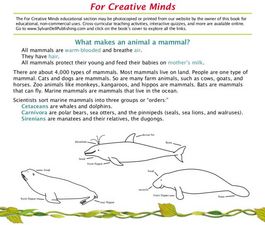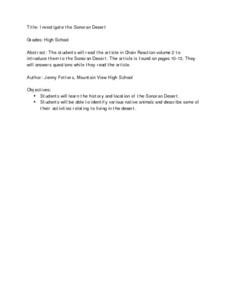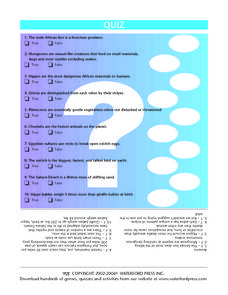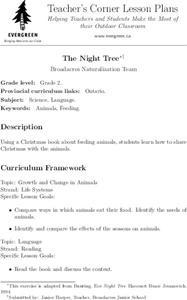Curated OER
Duck
In this ducks worksheet, students read information paragraphs about the habitat, reproduction, feeding and adaptation of ducks. Students study the photograph of the bird. There are no questions to answer here.
Curated OER
Reptiles and Birds
In this reptile and bird worksheet, students will read a paragraph about reptile characteristics and then answer 2 short answer questions. Then students will read a paragraph about bird characteristics and complete 2 short answer questions.
Curated OER
Animal Mouth Structures
Students study how the mouth structures of animal show their adaptation. In this animal mouth structure lesson, students look at images of bird and animal mouths as they are feeding focusing on the shape of each. They watch a movie that...
Curated OER
A Model for Natural Selection- Spaghetti Worms
Does the early bird really get the worm? If so, which color of worm does it prefer? In an exciting and easy week-long field investigation, young field biologists set up a one square meter feeding area for birds. If you have a webcam,...
Curated OER
Animal Instincts
Students compare animal adaptations to human behavior. In this science lesson, students discuss animal instincts vs. learned behavior. Options for student writing, drawing and research are incorporated into this lesson plan
Curated OER
Mammal Characteristics
In this mammals worksheet, students review the characteristics of mammals including their adaptations for survival and reproductive strategies. This worksheet has 2 short answer, 5 matching, 5 fill in the blank, 8 true or false, and 4...
Curated OER
Symbiosis and Co-evolution
By choosing a species and researching an adaptive symbiotic relationship it shares with another species, your young scholars are able to investigate a symbiotic relationship in a lab setting. They create a presentation using a variety of...
Curated OER
Adaptable Mandibles
Students define adaptation and highlight example of adaptation in birds and other animals. They study feeding techniques of seabirds and investigate the effect that trash has on wildlife.
Curated OER
How Fire Affects Wildllife
In this ecology lesson, students select an animal to study and read about how this animal adapts to ecological disaster. They complete 5 short answer questions after reading.
ARKive
Biodiversity and Evolution
Why is diversity in biology so important for an ecosystem? Explore biodiversity, evolution, and natural selection with a presentation for your biology class. It features clear information, activities for further understanding, and...
Curated OER
Barn Owl
In this barn owl worksheet, students read four paragraphs of information about barn owls, and study a photograph. There are no questions here.
Curated OER
Battle of the Beaks
Students explore adaptive advantage, based on beak function, by simulating birds competing for various foods.
Curated OER
Night Hike
Learners explore Upham Woods at night and investigate about the special adaptations of nocturnal animals. They identify three nocturnal animals and how they are adapted to the night. Students explain what night vision is and how it works.
Curated OER
Hedgehog
In this hedgehog worksheet, students read information paragraphs about the habitat, reproduction, feeding and adaptation of hedgehogs. Students study the photograph of the mammal. There are no questions to answer here.
Curated OER
For Creative Minds: What Makes an Animal a Mammal?
Students read about categories of mammals and their features. Students then construct a marine animal, using given print outs in the lesson. Students then create adaptations for their mammal, using a web site reference for guidance.
Curated OER
Eeks Beaks
Seventh graders examine the concept of adaptations that take place in the wild. Birds are the focus organism for this study. They examine the beaks of different birds and point out the differentiations.
Curated OER
FLY HIGH!!!
Students create their own bird study in their own schoolyard using the scientific method (see Testing a Hypothesis in Join the Project). Students do research in the library, at a local college, or on the Internet to determine the...
Curated OER
Investigate the Sonoran Desert
Students read article in Chain Reaction about the Sonoran Desert and answer questions.
Curated OER
Owl Pellets
Students examine and discuss what owls eat and how their digestive system works. They dissect owl pellets, identify the bones found, and analyze and record the results.
Curated OER
Here Today, Gone Tomorrow....?
Understanding the effects of an introduced species on the population of native species
Curated OER
Wacky Water Critters
Students visit a local creek or stream. They collect water samples from the creek and observe and sort the "water critters" they find in the sample, observing smaller organisms under a microscope if necessary. They identify each organism...
Curated OER
Quiz: African Animals
In this science worksheet, 3rd graders will respond to questions pertaining to African animals. Students will answer ten questions consisting of true/false, and multiple choice.
Curated OER
The Night Tree
Second graders explore the book, Night Tree, by Eve Bunting. They read and discuss the story, identify what the tree did for the animals, create a food chain for animals to hang on a tree, and decorate a tree at school.

























